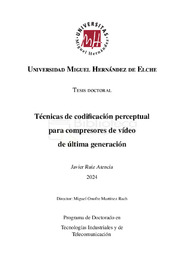Por favor, use este identificador para citar o enlazar este ítem:
https://hdl.handle.net/11000/35694Técnicas de codificación perceptual para compresores de vídeo de última generación
| Título : Técnicas de codificación perceptual para compresores de vídeo de última generación |
| Autor : Ruiz Atencia, Javier |
| Tutor: Martínez-Rach, Miguel Onofre |
| Editor : Universidad Miguel Hernández |
| Departamento: Departamentos de la UMH::Ingeniería de Computadores |
| Fecha de publicación: 2024 |
| URI : https://hdl.handle.net/11000/35694 |
| Resumen : Esta tesis aborda el desarrollo de técnicas avanzadas de codificación perceptual aplicadas al estándar de codificación de vídeo HEVC (H.265). En un contexto de creciente demanda de contenido audiovisual en alta resolución, resulta crucial desarrollar algoritmos de compresión más eficientes que mantengan la calidad visual percibida por el espectador. En el primer bloque se investiga en profundidad el rendimiento de diversas herramientas de codificación presentes en el estándar HEVC desde una perspectiva perceptual. Utilizando métricas objetivas como la SSIM, MS-SSIM y PSNR-HVS-M, se comparan diferentes técnicas de codificación, evaluando tanto su impacto en la calidad visual subjetiva como su eficiencia en la compresión. El trabajo revela importantes hallazgos sobre cómo optimizar la relación tasa-distorsión (Rate-Distortion, R/D), sentando las bases para mejoras futuras en la codificación perceptual. El segundo bloque de la tesis introduce una metodología que combina modelos de sensibilidad al contraste y enmascaramiento por textura para ajustar dinámicamente los parámetros de cuantificación (QP) en función del contenido visual. Este enfoque híbrido permite una mayor adaptación del codificador a las características de la escena, maximizando la eficiencia de compresión en las regiones de mayor relevancia perceptual, preservando los detalles visuales más importantes para el espectador. Finalmente, en las conclusiones, se resumen las principales contribuciones de la tesis, destacando los avances en la codificación perceptual y sus implicaciones en el futuro de los estándares de vídeo. Asimismo, se proponen líneas de desarrollo posteriores, orientadas hacia la implementación en tiempo real y la generalización de los modelos presentados a otros estándares de compresión de vídeo. En conjunto, las contribuciones de esta tesis representan avances significativos en la codificación de vídeo perceptual, destacando mejoras en la eficiencia de compresión sin comprometer la calidad visual. Asimismo, se proponen líneas de desarrollo futuras, orientadas hacia la implementación en tiempo real, el uso de redes neuronales y la generalización de los modelos presentados a otros estándares de compresión de vídeo más recientes. This thesis addresses the development of advanced perceptual coding techniques applied to the HEVC (H.265) video coding standard. In the context of increasing demand for high-resolution audiovisual content, it is crucial to develop more efficient compression algorithms that maintain the visual quality perceived by the viewer. In the first section, the performance of various coding tools present in the HEVC standard is investigated in depth from a perceptual perspective. Using objective metrics such as SSIM, MS-SSIM, and PSNR-HVS-M, different coding techniques are compared, evaluating both their impact on subjective visual quality and their efficiency in compression. The study reveals important findings on how to optimize the rate-distortion (R/D), laying the groundwork for future improvements in perceptual coding. The second section of the thesis introduces a methodology that combines contrast sensitivity models and texture masking to dynamically adjust the quantization parameters (QP) based on visual content. This hybrid approach allows the encoder to better adapt to scene characteristics, maximizing compression efficiency in regions of higher perceptual relevance, preserving the most important visual details for the viewer. Finally, in the conclusions, the main contributions of the thesis are summarized, highlighting the advances in perceptual coding and their implications for the future of video standards. Additionally, future development lines are proposed, focusing on real-time implementation and the generalization of the presented models to other video compression standards. Overall, the contributions of this thesis represent significant advances in perceptual video coding, highlighting improvements in compression efficiency without compromising visual quality. Furthermore, future development paths are proposed, focusing on real-time implementation, the use of neural networks, and the generalization of the models presented to more recent video compression standards. |
| Palabras clave/Materias: codificación herramientas normas medición cuantificación (señal) evaluación de la calidad secuencias de vídeo HEVC codificación perceptual enmascaramiento de textura enmascaramiento de contraste MDV SVM QP adaptativo encoding tools standards measurement quantization (signal) quality assessment video sequences perceptual coding texture masking contrast masking adaptive QP |
| Área de conocimiento : CDU: Ciencias aplicadas: Ingeniería. Tecnología |
| Tipo de documento : info:eu-repo/semantics/doctoralThesis |
| Derechos de acceso: info:eu-repo/semantics/openAccess Attribution-NonCommercial-NoDerivatives 4.0 Internacional |
| Aparece en las colecciones: Tesis doctorales - Ciencias e Ingenierías |
 La licencia se describe como: Atribución-NonComercial-NoDerivada 4.0 Internacional.
La licencia se describe como: Atribución-NonComercial-NoDerivada 4.0 Internacional.
.png)
